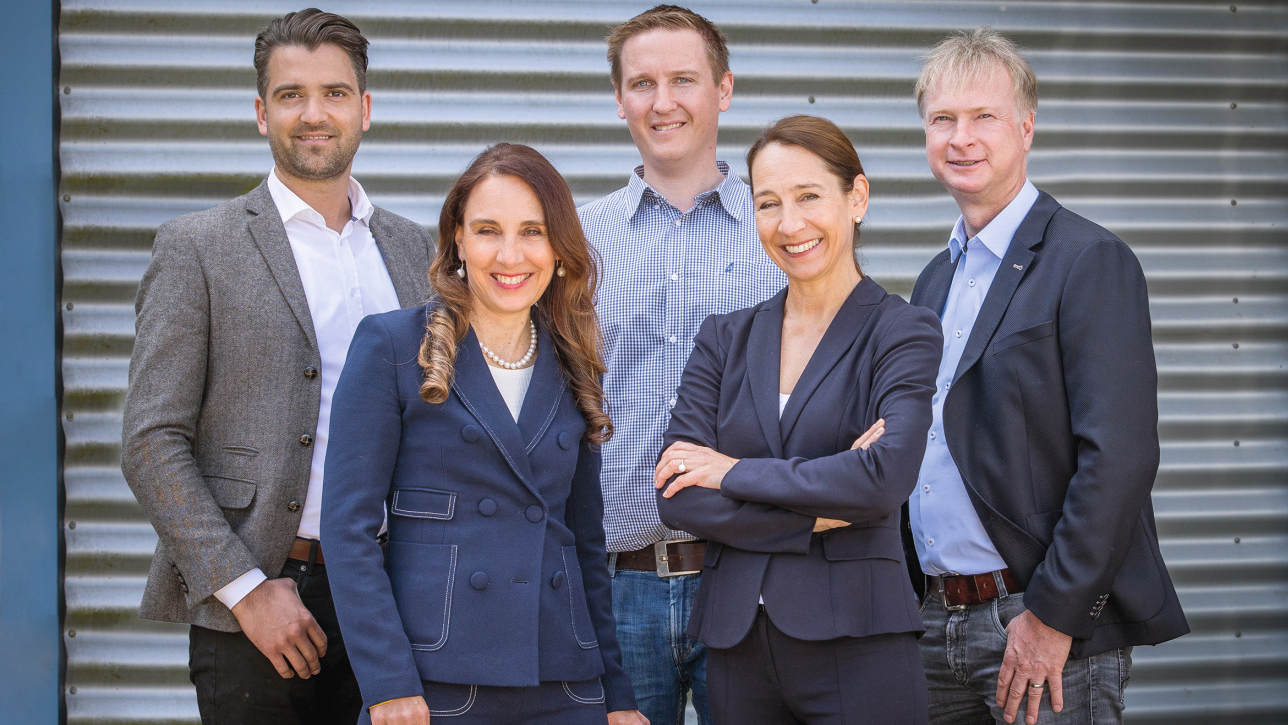Thoma Metallveredelung from Heimertingen has introduced the EHLA process to extend its coating range to XXL components. The hard chrome plating company is thus pursuing an alternative growth path.
Clamped into the system, the S235 steel test bar rotates while the powder for extreme high-speed laser cladding (EHLA) is prepared in an adjacent room of the production cell. Shortly afterwards, a glistening beam of light emerges from the laser head, melts a small area on the substrate surface with sparks and then sprays a layer of molten metal powder onto the surface - with iron, nickel, carbide or a mixture of these, depending on the desired surface properties. The process, which can be observed behind the small viewing window of the ultra-modern production cell, is extremely energy-efficient. 1.5 to 4 kW of power is directed only at the laser spot, which is only around 1 to 2 millimetres in size, and yet remarkable coating speeds of 40 to 200 meters per minute are achieved with layer thicknesses from 25 μm. This means that the process developed by the Fraunhofer Institute for Laser Technology ILT around ten years ago has passed the industrial maturity test.
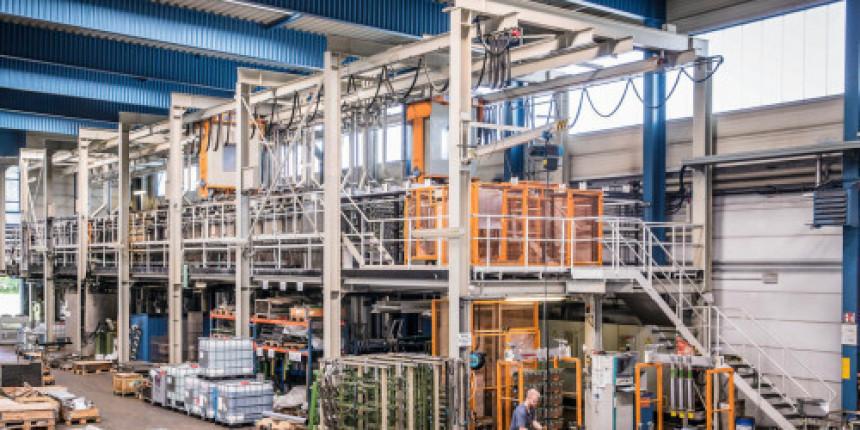 Electroplating with zinc and zinc alloys is another pillar of Thoma Metallveredelung's business
Electroplating with zinc and zinc alloys is another pillar of Thoma Metallveredelung's business
Pioneer in industrial testing
The site of the event is not a new industrial laser production complex; the pioneer in the industrial testing of the process is the electroplating company Thoma Metallveredelung in Heimertingen near Memmingen, a company that can look back on 99 years of company history. "I have no adhesion problems with EHLA, it offers super-efficient energy input and the powder is also used extremely efficiently," enthuses Thoma Managing Director Andrea Thoma-Böck, who runs the family business with her sister Christine Thoma-Kemser. Her Technical Plant Manager and electroplating technician Hannes Kircher describes the production process as a mixture of normal laser deposition welding and thermal spraying, in which molten metal powder is projected onto surfaces using a gas stream. This is also where the powders used in Heimertingen come from. The only difference is the grain size.
Kircher and his colleague and deputy Michael Tönnjes, also an electroplating technician, are in charge of the production preparations for the EHLA system and have been busy familiarizing themselves with the material for some time. The company decided to invest a seven-figure sum in the introduction of the process without any existing customer orders. An investment in the future according to the motto "tradition and innovation", a corporate philosophy that, according to Andrea Thoma-Böck, has ensured the existence of the family business for almost a century. A laboratory is currently being set up to carry out grinding and coating analyses independently and to test new powder and material combinations. However, the Heimertingen electroplaters still have some development work to do before laser coating can be used on a large scale.
EHLA: coating, repairing, mending
Even if no customer orders substantiate the imminent introduction, there are sound economic reasons why Thoma Metallveredelung is relying on the new process. The company, with around 130 employees, is known for hard chrome plating. Its customers come from the hydraulics industry, the earthmoving sector, which requires special rotationally symmetrical components for cranes and excavators, and the roller industry. To date, hydraulic rods and other XXL components of up to 3.80 meters in length have been made wear and corrosion resistant in the special chrome baths in the factory halls. However, customers also want larger dimensions.
The process is capable of coating rotationally symmetrical components up to 6 meters long.
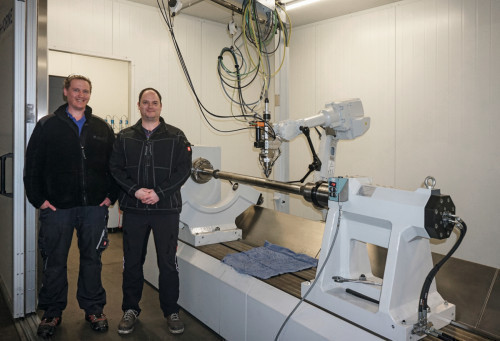 Michael Tönnjes, Deputy Manager, and Hannes Kircher, Technical Manager (from right to left). The two electroplating technicians oversee the production preparations for the EHLA system and have been familiarizing themselves with the material since 2021Andthis is where EHLA comes into play: the process is capable of coating rotationally symmetrical components up to 6 meters long. However, it is not just the dimensions of the coating spectrum that are expanding, there are also other possibilities: "Areas can be milled out and filled with EHLA," says Thoma-Böck, enthusiastically describing the repair coating with the laser process. In addition, components can be adapted, e.g. with undersize, and the powder compositions can be varied almost infinitely, allowing the properties of surfaces to be controlled and specifically adapted to customer requirements. "Carbide gives the surface hardness, nickel corrosion resistance and iron a bit of both," says Sales Manager and master electroplater Robert Rohn, outlining the options offered by the metal powders used to date alone.
Michael Tönnjes, Deputy Manager, and Hannes Kircher, Technical Manager (from right to left). The two electroplating technicians oversee the production preparations for the EHLA system and have been familiarizing themselves with the material since 2021Andthis is where EHLA comes into play: the process is capable of coating rotationally symmetrical components up to 6 meters long. However, it is not just the dimensions of the coating spectrum that are expanding, there are also other possibilities: "Areas can be milled out and filled with EHLA," says Thoma-Böck, enthusiastically describing the repair coating with the laser process. In addition, components can be adapted, e.g. with undersize, and the powder compositions can be varied almost infinitely, allowing the properties of surfaces to be controlled and specifically adapted to customer requirements. "Carbide gives the surface hardness, nickel corrosion resistance and iron a bit of both," says Sales Manager and master electroplater Robert Rohn, outlining the options offered by the metal powders used to date alone.
Environmental award for sophisticated electroplating technology
In the meantime, coating, electrogalvanizing and electroless nickel plating continue to be carried out in the factory halls in chrome baths. The hybrid coating of electroless nickel and hard chrome is also popular and the biggest sales driver. 600 to 800 customers rely on the quality work from Thoma.
During the tour, Kircher passes the mechanical processing area and points to other production areas such as waste water treatment, quality management and shipping. Four manual chrome plating systems are in operation in Heimertingen. A component - presumably an oversized piston rod - is firmly fixed and partially taped over a round bath before being lowered into the bath. In contrast to galvanizing and nickel plating, significantly more electricity is required for chrome plating. The firm fixing of the components ensures the required continuous contact. If the current is then switched on, up to 8000 amperes flow. This is necessary because the current yield of 25 % for chrome plating is significantly lower than for other electroplating processes. A lot brings a lot - but not only that.
8000 liters of 88-degree electrolyte move around in the system
Hard chrome specialist Thoma Metallveredelung won the environmental award with a system in which the electricity yield during the process remains unchanged, but the efficiency, i.e. the process efficiency of the system, has been increased to 95% - "with recovery, current control and reactor technology", as Kircher proudly explains. The current Technical Director originally learned his trade from Prof. Unruh in Nuremberg. When it comes to the subtle difference between efficiency and current yield, which was always important to Prof. Unruh, Kircher still fondly remembers the electroplating luminary.
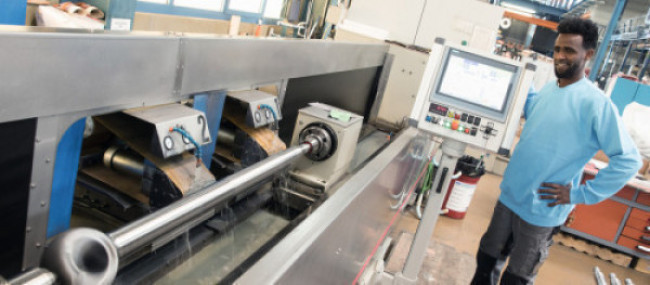 Rotationally symmetrical components are the specialty of Thoma Metallveredelung in HeimertingenThesystem also has a practical advantage: it is twice as fast. The company is also proud of its popular hybrid coatings, for which Thoma Metallveredelung was once one of the technology pioneers: "This system dates back to 1992," explains Kircher. "It can electroless nickel plate components up to 3 meters long. There are 8,000 liters of 88-degree electrolyte in the system - very energy-intensive, but it is also a very good coating in terms of corrosion protection," he emphasizes. What is striking is that many systems have been equipped with new, larger rectifiers. The technology is state of the art. Efficiency, environmental protection, recovery and occupational safety are the magic words here.
Rotationally symmetrical components are the specialty of Thoma Metallveredelung in HeimertingenThesystem also has a practical advantage: it is twice as fast. The company is also proud of its popular hybrid coatings, for which Thoma Metallveredelung was once one of the technology pioneers: "This system dates back to 1992," explains Kircher. "It can electroless nickel plate components up to 3 meters long. There are 8,000 liters of 88-degree electrolyte in the system - very energy-intensive, but it is also a very good coating in terms of corrosion protection," he emphasizes. What is striking is that many systems have been equipped with new, larger rectifiers. The technology is state of the art. Efficiency, environmental protection, recovery and occupational safety are the magic words here.
Regulation slows growth
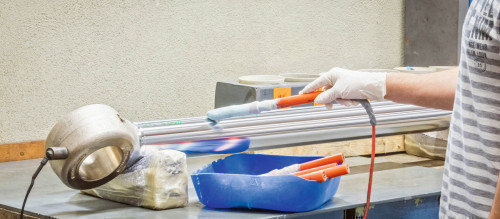 Mobile electroplating is an interesting service. Smaller areas can be repaired and selectively touched up using pad electroplatingButthere is another reason for this besides the commitment to innovation. Given the relatively high number of employees at the family-run company and the associated quantity of chemicals used, Thoma Metallveredelung is considered to be a so-called incident company. "We are always on the radar," emphasizes Robert Rohn, who originally comes from the anodizing sector. Incident companies are not allowed to expand without further ado and are regularly inspected. This regulation is one of the reasons why Thoma Metallveredelung is entering the non-energy-intensive and non-electrochemical EHLA technology, even if the process - as Andrea Thoma-Böck emphasizes - is currently only a supplement to the existing coating range.
Mobile electroplating is an interesting service. Smaller areas can be repaired and selectively touched up using pad electroplatingButthere is another reason for this besides the commitment to innovation. Given the relatively high number of employees at the family-run company and the associated quantity of chemicals used, Thoma Metallveredelung is considered to be a so-called incident company. "We are always on the radar," emphasizes Robert Rohn, who originally comes from the anodizing sector. Incident companies are not allowed to expand without further ado and are regularly inspected. This regulation is one of the reasons why Thoma Metallveredelung is entering the non-energy-intensive and non-electrochemical EHLA technology, even if the process - as Andrea Thoma-Böck emphasizes - is currently only a supplement to the existing coating range.
"The properties of a hard chrome layer cannot currently be fully reproduced technically with any other process"
"The properties of a hard chrome layer cannot currently be fully reproduced technically with any other process," emphasizes the entrepreneur, who has become a figurehead in the industry for an industrial electricity price and transparent chemicals legislation and also laments the general investment backlog. For the company boss, who together with her sister is responsible for a workforce of well over 100 employees, the company's development is severely hampered by the lack of clarity in the current chemicals legislation. She argues that the desired substitution of hard chrome in the form of electroplating processes will only be possible once the substances affected by "essential use" under the Green Deal are known. The background to this is that no targeted research and development work can take place as long as there is uncertainty. Thoma Metallveredelung's corporate philosophy of tradition and innovation has worked well for almost a century, so this strategy should also work in this case - because EHLA technology is certainly an innovative and promising approach.

